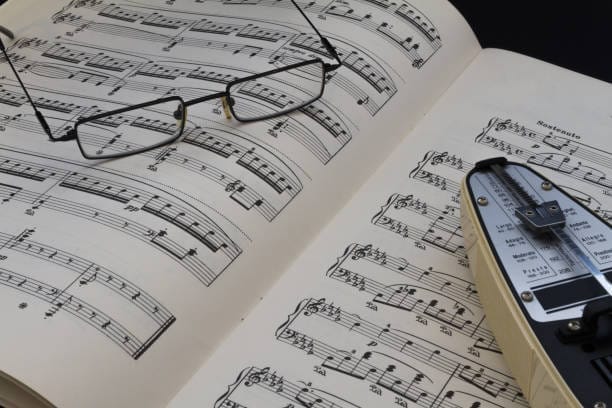How to pick a right tempo (speed) with the metronome to practice
1. Start Slow—Mastery Over Speed
When you first learn a piece, it’s crucial to start at a slow tempo. But beyond simply slowing down, take a moment to analyze the music visually before you begin. Identify the fastest rhythm or the most challenging part of the section you are working on, as these will determine your starting tempo.
For example:
Scan the Score: Look for fast note runs, tricky rhythms, or complex fingerings.
Set a Realistic Tempo: If the fastest rhythm in the section is eighth notes, set your metronome to match the eighth-note beats. The tempo should allow you enough time to prepare each finger and position it on the correct key before playing.
Why Is This Important?
When you practice slowly with deliberate preparation:
You ensure that your fingers are placed correctly, preventing mistakes and developing muscle memory.
You can focus on producing the exact sound and touch you want for each note, whether it’s smooth legato, crisp staccato, or another articulation.
How to Practice with Preparation
Break It Down: Work on just one section or even one measure at a time.
Set the Tempo: Choose a speed where you can comfortably prepare and play each note. This means placing your fingers on the correct keys before striking them, rather than rushing and hoping to “hit” the right notes.
Focus on the Details:
Use the best fingering for the passage to ensure fluidity.
Pay attention to the dynamics, touch, and expression you want to bring out in the music.
Use the Metronome: Align the clicks with the smallest rhythmic value in the section (e.g., eighth notes) to keep your timing steady.
Example
If you’re practicing a passage with fast eighth notes and a tricky hand position shift:
Analyze where the shifts occur and what fingering makes the transition smooth.
Set the metronome to a tempo where each eighth note aligns with a click, even if it feels very slow.
Play through the passage, focusing on preparing your hand position before each note and executing it with the intended touch.
The Goal
By practicing in this way, you’re not just training your fingers to play the notes—you’re building the habit of deliberate preparation and accuracy. This method ensures that every note is played with intention, leading to a clean and expressive performance when you eventually increase the tempo. Remember, it’s better to practice slowly and correctly than to rush and develop habits that are hard to fix later.

2. Choose a Manageable Practice Tempo
A manageable practice tempo is one where you can play the music correctly and comfortably without tension. To find this tempo, ask yourself:
- Can I prepare the correct finger or hand position on the correct key before I play with confidence?
If the answer is no, then the tempo you’ve chosen is too fast.
How to Adjust the Tempo
Start Slower:
- Set the metronome to a speed where you can confidently prepare your fingers and hand movement before each note.
- Focus on mindful preparation. This means placing the correct finger on the correct key and ensuring your hand is relaxed and ready for the next movement.
Repeat for Accuracy:
- Play the section several times at this slower tempo until you can consistently prepare and play with confidence.
- If mistakes or tension creep in, slow the metronome down further and try again.
Gradual Speed Increases
Once you can play the section accurately and confidently at the slower tempo:
1. Increase by 4–5 Clicks:
- Raise the metronome speed slightly and repeat the process.
- Focus on maintaining accuracy and confidence as you adjust to the new tempo.
2. Repeat the Process:
- Play the passage multiple times at each new tempo until it feels comfortable and controlled.
- Continue increasing by small increments (4–5 clicks) and repeating until you reach the final performance tempo.
Progress Over Time
You don’t need to reach the final tempo in one practice session. Instead:
- Build Progress Gradually: Increase the tempo a little each day.
- Track Your Tempo: Write down the speed you reached during each practice session. The next day, pick up from where you left off and continue building.
This approach ensures steady improvement without rushing, allowing you to master both the notes and the confidence needed to play them. Over time, you’ll find that even challenging sections become manageable and fluid at the final performance speed.
By practicing this way, you’re not just training for accuracy but also building confidence and control, which are essential for expressive and polished performances.

3. Vary the Tempo for Musicality
While the metronome is an excellent tool for building steady timing and technical precision, music is about much more than strict beats. Once you’re confident with the notes and rhythms, it’s time to explore the musicality of the piece.
Understand the Musical Context
To find the ideal final tempo for your piece:
- Check the Tempo Marking: Look for indications like Andante, Allegro, or Adagio in the score, which provide clues about the intended speed and mood.
- Consider Expression Suggestions: Dynamic markings and phrasing indications, such as dolce (sweetly) or con brio (with vigor), can help you understand the character of the music.
- Listen to Recordings: Explore different interpretations of the piece online to hear how other musicians approach the tempo, style, and character.
This research will give you a clearer picture of how the piece should sound, helping you make more informed choices as you shape your performance.
Practice Tempo Variations
Once you’ve established the final tempo goal:
1. Test Your Control: Practice slightly faster or slower than the intended performance tempo.
- Playing faster challenges your technical precision.
- Playing slower allows you to focus on tone, touch, and shaping the music.
2. Turn Off the Metronome: Spend some time without the metronome to:
- Emphasize dynamics, phrasing, and musical expression.
- Experiment with subtle tempo fluctuations (rubato) where appropriate to bring out the emotion and character of the piece.
Fast Isn’t Always Better
Resist the temptation to rush through a piece to “show off” your capabilities. Faster isn’t always more impressive—what matters most is how well you convey the music’s character.
- For fast pieces, maintain clarity and articulation. Speed should never come at the expense of accuracy or musicality.
- For slow pieces, keep a forward and flowing movement. Avoid stagnation by maintaining an inner sense of pulse, ensuring the music breathes naturally while staying expressive.
Final Thought
Varying the tempo during practice helps you strike a balance between technical precision and musical artistry. By understanding the style and character of the piece, you can make thoughtful decisions about tempo and bring out the music’s full emotional depth. Let the music guide you, and aim for a performance that feels both controlled and expressive.
Share this article on



